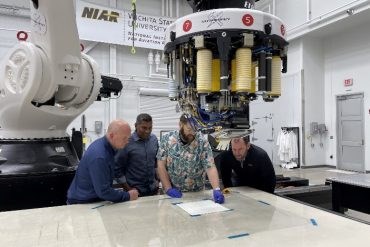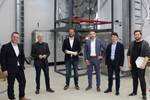Axiom partners with NIAR ATLAS for oxide-oxide CMC research
Partnership breaks cost and process scalability barriers through the development of oxide-oxide CMC prepreg using AFP technology.

Photo Credit: NIAR ATLAS
Recently, the (ATLAS) at Wichita State University’s (WSU) National Institute for Aviation Research (NIAR) began working with Axiom Materials (Santa Ana, Calif., U.S.) to produce an oxide-oxide ceramic matrix composite (CMC) prepreg using automated fiber placement (AFP) technology.
AX-7810UD-330N610, is a solvent-based unidirectional (UD) material and can be used for high-temperature applications up to 1,650°F (899°C), such as in engine components. However, while oxide-oxide CMC are said to be a proven material for low-density, high-temperature components that demand high thermo-structural performance, widespread usage has been limited due to cost and process scalability.
“Our collaboration with NIAR has allowed us to break through these barriers,” Wylie Simpson, lead CMC engineer and supervisor at Axiom Materials, says. “These automated processes significantly improve layup rates and consistency when compared to traditional hand layup. They also lower material scrap rates and increase the size and scale of components that may be produced.”
Several material variants were slit using NIAR’s custom-made tape slitter and tow-rewinding machine manufactured by Mikrosam (Prilep, Macedonia). This slitter is capable of continuous in-process inspection to investigate the slit-tape quality in order ensure that the material will process through the AFP head without causing manufacturing defects.
“We made some modifications to the AFP system in order to process CMC materials so that the tape would lay down for automated layup and part production,” Josh Goertz says, a senior research engineer at ATLAS who has more than ten years of experience with AFP systems.
According to ATLAS director Waruna Seneviratne, with its partnership with Axiom, ATLAS is planning to produce a representative aircraft part and demonstrate the slitting and AFP process for CMC.
Learn more about WSU-NIAR in CW’s recent plant tour.
Related Content
-
Carbeon C/C-SiC ceramic matrix composites without fiber coating
Dutch startup Arceon is working with leaders in space, hypersonics and industry to test its Carbeon CMC, validating near-net-shape parts with <3% porosity and performance at 1600ºC, targeting UHTCMC and a presence in the U.S. in 2025.
-
Converting carbon fiber for UHTCMC to 3500°C
Advanced Ceramic Fibers LLC demonstrates ultra-high temperature ceramic matrix composites using SiC and other metallic carbides for applications in aerospace, defense, energy and more.
-
Firefly Aerospace to develop CMC rocket engine nozzle extension
Contracted by the AFRL, Firefly will use its expertise to design, build and test a composite-based nozzle extension to reduce costs, improve performance and accelerate rocket engine production.






